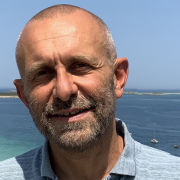
Copyright : Laboratoire LEMAR- 2018
Philippe Cugier et Martin Marzloff (Ifremer, ODE/DYNECO/LEBCO, UMR EIO)
National
Labex Mer
Start Date
03/04/2025
End Date
03/04/2025
The life cycle of benthic invertebrate species is generally characterized by a succession of contrasting developmental stages, including a pelagic larval stage closely conditioned by hydrodynamics, and the juvenile and adult benthic stages associated with the substrate. Different interactions with biotic and abiotic factors are involved throughout these development phases, contributing to the spatial and temporal dynamics of benthic populations and communities. The MODELISME project aims to improve the understanding of certain mechanisms that affect benthic invertebrates during the (1) pelagic larval and (2) substrate recruitment phases by using modelling tools, combined with in situ observations and genetic analyses. In particular, the project proposes to study:
(1) When pelagic larvae disperse with currents, both larval behaviour and ecology (date and duration of laying; survival; development time) and hydrodynamic conditions that influence larval fate and connectivity between spawning and larval recruitment areas (Ellien et al., 2004, Paris et al., 2007, Nicolle et al., 2013).
(2) During the colonization of the substrate by larvae, which represents a critical phase of the life cycle, affinity with sediment, tropism towards established adult populations or adapted habitat.
The project focuses on several benthic species of the Rade de Brest characterized by contrasting larval life cycles, distinct spatial distributions (partly stratified) and divergent demographic histories (expansion and/or decline). The expected results will aim to characterize the spatial variability of recruitment for these different species, and to quantify the effects of ecology and larval behaviour on connectivity (contrast between species), the effects of environmental gradients (Alder vs Elorn) on recruitment success, and for some species, the contribution of external larval inputs to the Rade de Brest (connectivity with the Iroise Sea).
Alain Ménesguen, Ifremer, Unité Dynamiques des Ecosystèmes Côtiers, Laboratoire d’Ecologie Benthique Côtière (LEBCO), Modélisation MARS3D de la dispersion larvaire.
Antoine Carlier, Ifremer, Unité Dynamiques des Ecosystèmes Côtiers, Laboratoire d’Ecologie Benthique Côtière (LEBCO), Biologiste Benthologue, expérimentations recrutement larvaire (crépidule principalement).
Aline Blanchet, Ifremer, Unité Dynamiques des Ecosystèmes Côtiers, Laboratoire d’Ecologie Benthique Côtière (LEBCO), Biologiste Benthologue, expérimentations recrutement larvaire (ophiures principalement).
Xavier Caisey, Ifremer, Unité Dynamiques des Ecosystèmes Côtiers, Laboratoire d’Ecologie Benthique Côtière (LEBCO), Technicien, plongeur.

 MICROPLASTIC2
Scroll to top
MICROPLASTIC2
Scroll to top